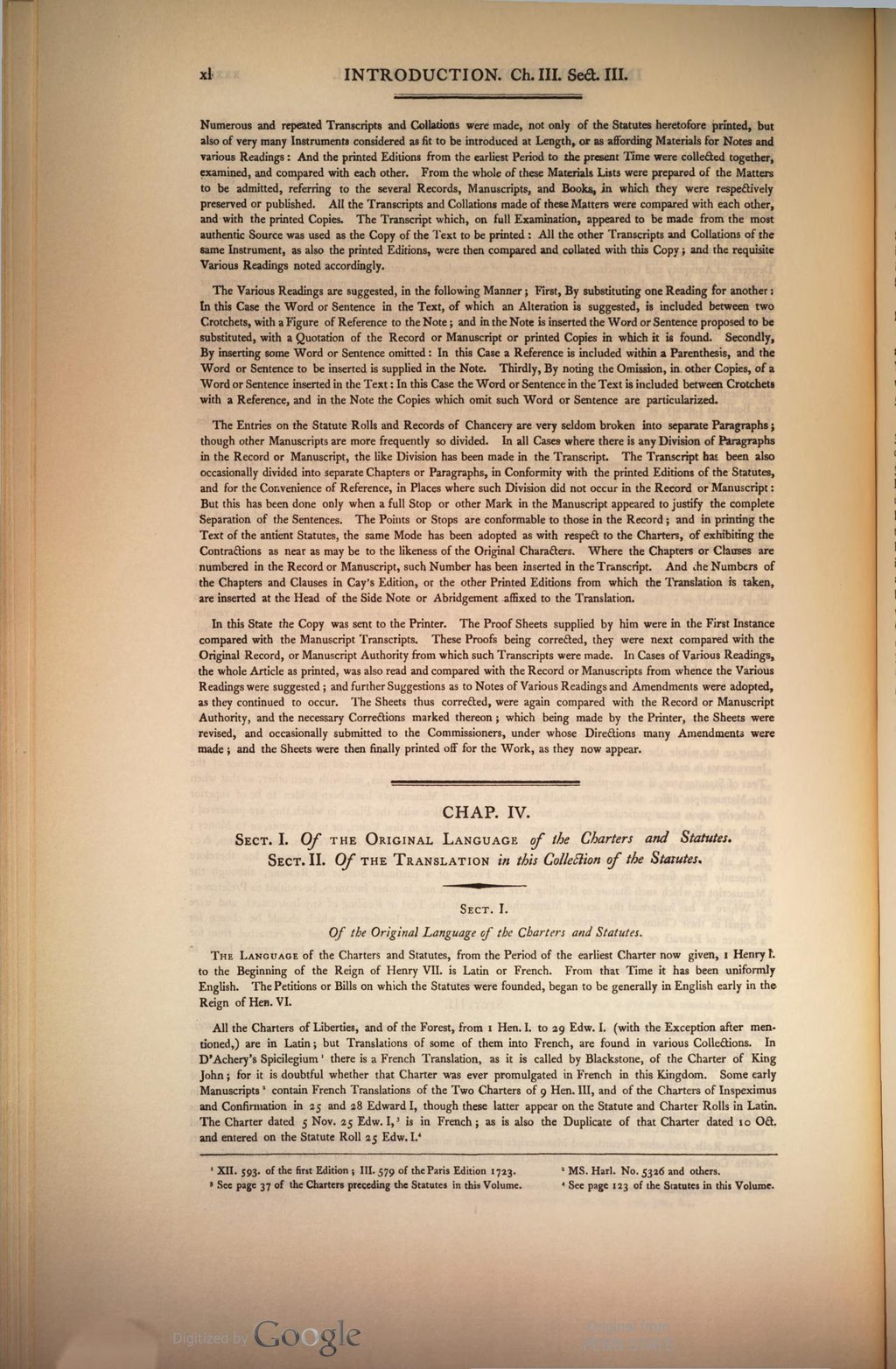The Various Readings are suggested, in the following Manner; First, By substituting one Reading for another: In this Case the Word or Sentence in the Text, of which an Alteration is suggested, is included between two Crotchets, with a Figure of Reference to the Note; and in the Note is inserted the Word or Sentence proposed to be substituted, with a Quotation of the Record or Manuscript or printed Copies in which it is found. Secondly, By inserting some Word or Sentence omitted: In this Case a Reference is included within a Parenthesis, and the Word or Sentence to be inserted is supplied in the Note. Thirdly, By noting the Omission, in other Copies, of a Word or Sentence inserted in the Text: In this Case the Word or Sentence in the Text is included between Crotchets with a Reference, and in the Note the Copies which omit such Word or Sentence are particularized.
The Entries on the Statute Rolls and Records of Chancery are very seldom broken into separate Paragraphs; though other Manuscripts are more frequently so divided. In all Cases where there is any Division of Paragraphs in the Record or Manuscript, the like Division has been made in the Transcript. The Transcript has been also occasionally divided into separate Chapters or Paragraphs, in Conformity with the printed Editions of the Statutes, and for the Convenience of Reference, in Places where such Division did not occur in the Record or Manuscript: But this has been done only when a full Stop or other Mark in the Manuscript appeared to justify the complete Separation of the Sentences. The Points or Stops are conformable to those in the Record; and in printing the Text of the antient Statutes, the same Mode has been adopted as with respect to the Charters, of exhibiting the Contractions as near as may be to the likeness of the Original Characters. Where the Chapters or Clauses are numbered in the Record or Manuscript, such Number has been inserted in the Transcript. And the Numbers of the Chapters and Clauses in Cay's Edition, or the other Printed Editions from which the Translation is taken, are inserted at the Head of the Side Note or Abridgement affixed to the Translation.
In this State the Copy was sent to the Printer. The Proof Sheets supplied by him were in the First Instance compared with the Manuscript Transcripts. These Proofs being corrected, they were next compared with the Original Record, or Manuscript Authority from which such Transcripts were made. In Cases of Various Readings, the whole Article as printed, was also read and compared with the Record or Manuscripts from whence the Various Readings were suggested; and further Suggestions as to Notes of Various Readings and Amendments were adopted, as they continued to occur. The Sheets thus corrected, were again compared with the Record or Manuscript Authority, and the necessary Corrections marked thereon; which being made by the Printer, the Sheets were revised, and occasionally submitted to the Commissioners, under whose Directions many Amendments were made; and the Sheets were then finally printed off for the Work, as they now appear.
CHAP. IV.
Sect. I. Of the Original Language of the Charters and Statutes.
Sect. II. Of the Translation in this Collection of the Statutes.
Sect. I.
Of the Original Language of the Charters and Statutes.
The Language of the Charters and Statutes, from the Period of the earliest Charter now given, 1 Henry I. to the Beginning of the Reign of Henry VII. is Latin or French. From that Time it has been uniformly English. The Petitions or Bills on which the Statutes were founded, began to be generally in English early in the Reign of Hen. VI.
All the Charters of Liberties, and of the Forest, from 1 Hen. I. to 29 Edw. I. (with the Exception after mentioned,) are in Latin; but Translations of some of them into French, are found in various Collections. In D’Achery’s Spicilegium[1] there is a French Translation, as it is called by Blackstone, of the Charter of King John; for it is doubtful whether that Charter was ever promulgated in French in this Kingdom. Some early Manuscripts[2] contain French Translations of the Two Charters of 9 Hen. III, and of the Charters of Inspeximus and Confirmation in 25 and 28 Edward I, though these latter appear on the Statute and Charter Rolls in Latin. The Charter dated 5 Nov. 25 Edw. I,[3] is in French; as is also the Duplicate of that Charter dated 10 Oct. and entered on the Statute Roll 25 Edw. I.[4]
